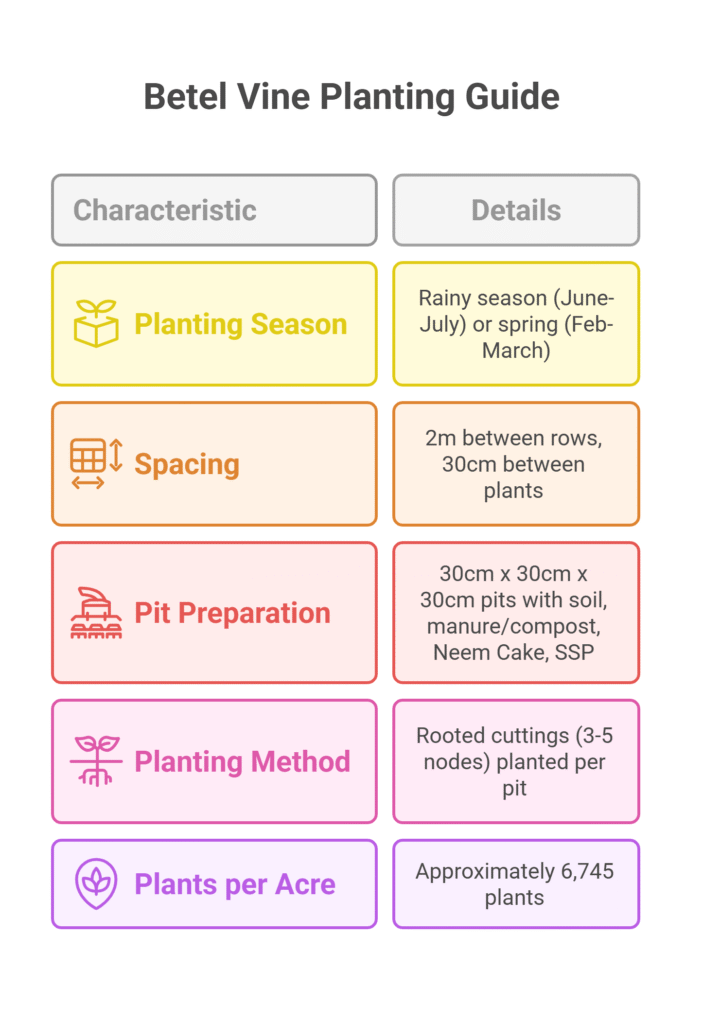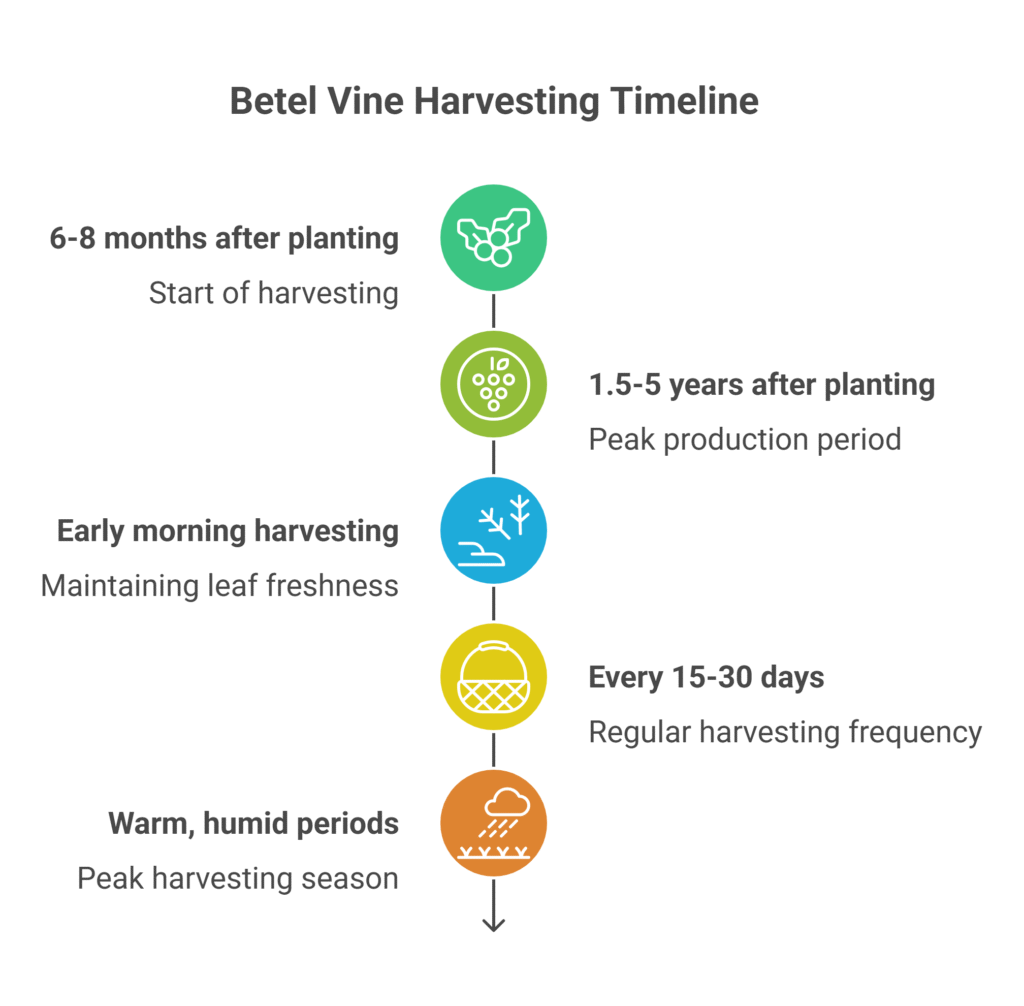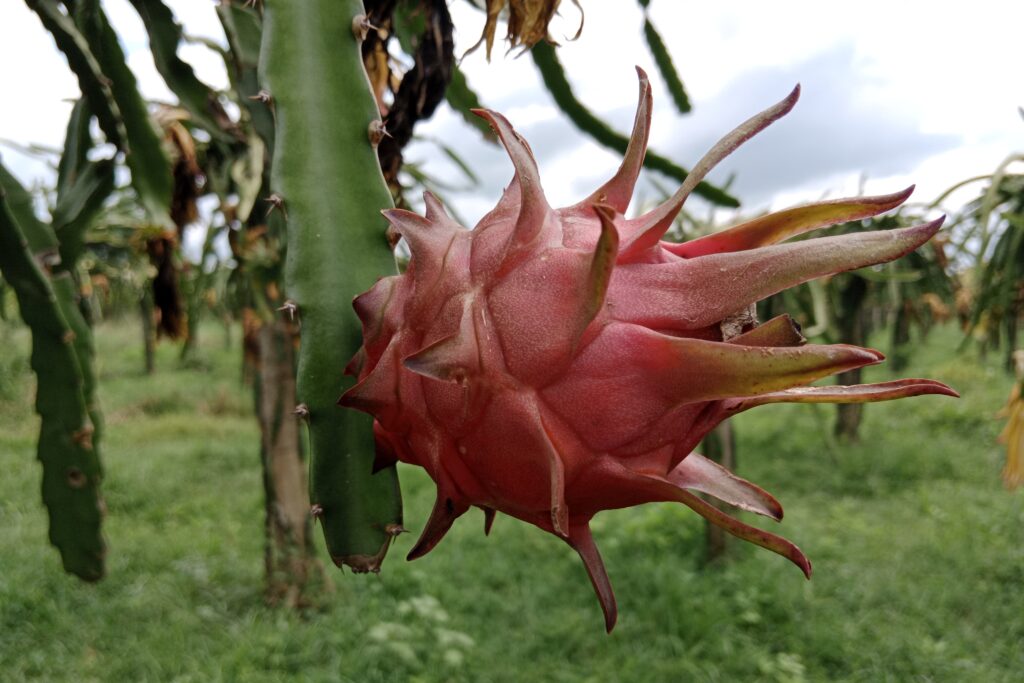Betel Leaf Farming
Betel Leaf Farming Profit Per Acre achieves its break-even point in Year 1 itself, yielding a net profit of NRs. 23,705, as the cumulative profit turns positive immediately due to moderate first-year yield and pricing. Peak profitability occurs during Years 3–5, generating the highest annual profit of NRs. 197,585, driven by maximum leaf production (110 leaves/plant) and economies of scale from fixed annual maintenance costs (NRs. 25,000). By Year 6, profit declines significantly to NRs. 93,037.5 (55% lower than peak years), primarily due to halved yield (50 leaves/plant), though partially offset by a higher leaf price (NRs. 35 per 100 leaves). This underscores the critical impact of vine age on Betel Leaf Farming Profit Per Acre.

Land Preparation
Land preparation for cultivation begins with thoroughly clearing the field by removing all weeds, stumps, rocks, and debris. This is followed by deep plowing to a depth of 18–24 inches, which helps loosen the soil, improve aeration, and promote better root penetration; typically, 2–3 cross plowings are recommended.
After plowing, harrowing, and leveling are done using a harrow or rotavator to break down large soil clods and ensure a fine, uniform surface for efficient water distribution and planting. Finally, raised beds (3–4 ft wide) or trenches (1–1.5 ft deep and wide) are formed depending on the crop’s drainage needs and the chosen support system, with raised beds being the most commonly used.
Support System Setup
Before planting, set up a sturdy support system by first erecting strong vertical poles—such as bamboo, casuarina, or concrete—6 to 8 feet tall and spaced at regular intervals. Horizontal G.I. wires are then strung between the poles at heights of approximately 1.5 feet and 4 feet. To facilitate vine climbing, horizontal bamboo or casuarina splits, or vertical coir ropes or wires, are installed from the ground up to the top wire, creating a structured framework for optimal plant support and growth.
Soil Type
The ideal soil for cultivation should be deep, fertile, and well-drained loamy soil rich in organic matter, though sandy loam to clay loam soils are also acceptable. Proper drainage is crucial, as stagnant water can lead to root rot; hence, heavy clay or waterlogged soils must be avoided. The optimal soil pH ranges from slightly acidic to neutral (5.5 to 6.8), while highly alkaline or saline soils are unsuitable. Additionally, a high organic matter content of 3–5% is essential for maintaining good soil structure, ensuring adequate moisture retention, and providing a steady nutrient supply.
Climatic Requirements
| Factor | Specific Requirements | Remarks |
| Temperature | · Minimum: 15°C · Optimum: 20°C – 35°C · Maximum: ~40°C | Frost or sustained temperatures below 10°C are detrimental. Growth is severely hampered outside the optimum range. |
| Rainfall & Humidity | · Annual Rainfall: 2250 mm – 4750 mm (Well-distributed) · Relative Humidity: 60% – 90% | Requires consistent soil moisture. High humidity is essential. Cannot tolerate waterlogging – excellent drainage is critical. |
| Light | · Preference: Partial Shade (50% – 70% sunlight) · Tolerance: Avoids full direct sun | Intense, direct sunlight scorches leaves. Grown under shade nets or intercropped with taller trees (e.g., Coconut, Areca nut). |
Major Cultivars
Because preferences for size, shape, thickness, pungency, and aroma differ greatly by region, the selection of cultivars should be based on local market demand. To ensure optimal growth and profitability, it is also crucial to select cultivars that offer good disease resistance and are well-suited to the local climate and soil conditions.
Major Cultivars of Betel Leaf by Country
| Country | Major Cultivars (Examples) |
| India | Bangla, Calcutta, Karapaku, Kauri, Godi, Kumbakonam, Tellaku, Pachaikkodi, SGM1, Cumbum |
| Nepal | Bangla, Calcutta, Karapaku, Kauri |
| Bangladesh | Deshi, Misti, Sanchi, Bari Paan-1, Bari Paan-2, Bari Paan-3 |
| Sri Lanka | Kalu bulath, Galduru |
| Indonesia | Sirih Cengkeh, Sirih Belanda, Sirih Hutan |
Seed Rate per Acre
Betel vine is mainly propagated vegetatively using stem cuttings rather than seeds, requiring approximately 10,000 to 12,000 rooted vine cuttings (setts) per acre, depending on the spacing and density of the support system used.
Planting
a) Planting Season
The optimal planting season for betel vine is at the start of the rainy season (June–July in South Asia), as the high humidity and moisture during this period support successful establishment; alternatively, planting can also be done in spring (February–March), provided that reliable irrigation is available.

b) Spacing
The recommended spacing configuration specifies 2 meters between rows and 30 centimeters between individual plants within a row; however, these distances may be adjusted based on the specific design of the support system used and the inherent vigor of the cultivar being planted.
c) Pit Preparation
Dig pits at the marked spots where vines will climb (e.g., below each vertical rope or split), typically sized 30 cm x 30 cm x 30 cm (1 ft cube), and fill each pit with a mixture of topsoil combined with either well-rotted farmyard manure (FYM) or compost (10-15 kg), plus 100g of Neem Cake and 50g of Single Super Phosphate (SSP).
d) Planting Method
The planting method involves using healthy, disease-free, semi-hardwood stem cuttings (setts) with 3-5 nodes, preferably pre-rooted in a nursery for 4-6 weeks; plant 2-3 of these rooted cuttings per pit, placing them carefully in the center of the prepared pit with their roots spread out, then cover firmly with the soil mixture while leaving the growing tip exposed, gently tie the exposed growing tip to the base of the vertical support (rope/split), and water thoroughly immediately after planting.
e) No. of Plants per Acre
Based on the recommended spacing, betel leaf vine cultivation can accommodate approximately 6,745 plants per acre, ensuring optimal growth, airflow, and ease of maintenance.
Intercropping
Intercropping in betel vine cultivation is commonly practiced with shade-providing trees such as Areca nut, Coconut, Jackfruit, Mango, or Banana to optimize land use and ensure the vines receive adequate shade. Additionally, during the early stages of vine establishment—before the canopy fully closes—shade-tolerant crops like ginger, turmeric, or pineapple are often grown beneath the vines to utilize the lower space effectively.
Irrigation
Irrigation is critical in betel vine cultivation, requiring consistently moist soil without waterlogging and high humidity; water daily during hot, dry periods, every 2-3 days in cooler/humid conditions, and reduce frequency during heavy rainfall. Drip irrigation is highly recommended for efficient root-zone water application, reduced leaf wetness (minimizing fungal disease risk), and water conservation—sprinklers increase leaf wetness while flood irrigation is unsuitable. Always avoid using saline or alkaline water.
Fertilizer and Manure
| Category | Specifications |
| Organic Matter Foundation | Heavy reliance on organic manures to improve soil structure, moisture retention, and microbial activity. |
| Basal Dose (per pit at planting) | • 1-2 kg FYM/compost • 100g Neem Cake • 50g SSP • 50g Trichoderma Viridae |
| Annual Application (per vine/year) | • Farmyard Manure/Compost: 4-8 kg • Nitrogen (N): 20-30g (e.g., Urea: 45-65g) • Phosphorus (P₂O₅): 15-20g (e.g., SSP: 95-125g) • Potash (K₂O): 30-40g (e.g., MOP: 50-65g) |
| Schedule | • Split into 4 doses/year • Apply organic manure during monsoon • Apply chemical fertilizers after weeding + light soil stirring, followed by irrigation |
Weed Control
Because weeds fiercely compete for nutrients, water, and light, controlling weeds is essential for growing betel vines. The most popular technique is manual weeding, which involves hand-pulling or hoeing every 15 to 30 days in the early stages and less frequently as the vine canopy closes. To avoid damaging the roots, deep weeding close to the vines should be avoided. Around the base of the vine, mulching with organic materials like paddy straw, dried leaves, or coir pith is also used to inhibit weed growth, retain soil moisture, and enhance organic matter. It is advised to periodically replenish the mulch.
Flowering and Fruit Management
The goal of flowering and fruit control in betel vine culture is to minimize reproductive growth and boost vegetative development for increased leaf yield. This is accomplished by routinely pinching and pruning, which involves removing flower spikes and developing fruits as soon as they appear. In order to encourage lateral branching and a bushier plant structure, weak or overly long growth tips are also pinched down. These methods assist in refocusing the plant’s energy so that it produces more marketable and tender leaves instead of seeds.

Pest and Disease Management
Common Pests
a) Scale Insect
Effective management of scale insects in betel vine begins preventatively by exclusively selecting scale-free seed vines for planting. At the very first sign of infestation—typically observing just one or two scales on the stem base or leaves—promptly apply Chlorpyriphos 20 EC (2 ml per liter of water), specifically drenching the vine base to effectively eliminate the pests. Alternatively, spray either Neem Seed Kernel Extract (NSKE) at 5% concentration or Malathion 50 EC (1 ml per liter) over the affected foliage and stems as a control measure.
b) Mites
Mites (Sevvattai) can damage crops by feeding on plant tissues, causing discoloration and reduced growth. They can be effectively controlled by spraying Wettable Sulphur 50 WP at 1 g/liter or Dicofol 18.5 EC at 0.5 ml/liter to suppress their population and protect plant health.
c) Shooty Mold
Sooty mould caused by aphid infestations affects plant health by blocking sunlight and reducing photosynthesis. To control aphids, spray Chlorpyriphos at 2 ml per liter on Agathi leaves, ensuring thorough coverage. Additionally, clip off excess Agathi leaves to improve airflow and reduce humidity, which discourages aphid buildup and mould development.
d) Mealy Bug
Mealybugs are sap-sucking pests that weaken plants by feeding on their juices, often leading to stunted growth and sooty mould development. They can be effectively managed by spraying Chlorpyriphos 20 EC at 2 ml per liter or Dimethoate 30 EC at the same concentration. It is important to concentrate the spray around the collar region of the plant, as mealybugs tend to accumulate in that area, ensuring better pest control and healthier plant growth.
e) Nematode
Nematode populations in betel vine can be managed by applying Neem cake at 1 ton per hectare or shade-dried Calotropis leaves at 2.5 tons per hectare to the soil. Additionally, soil application of beneficial microbes such as Bacillus subtilis or Pseudomonas fluorescens at 10 grams per vine helps control root knot nematodes and also protects against quick wilt disease, promoting healthier root development and vine growth.
Common Diseases
a). Foot rot/Stem rot (Phytophthora)
Foot rot or stem rot in betel vine, caused by Phytophthora spp., can be managed by using healthy, mature seed vines (over one year old) and soaking them for 30 minutes in Streptocycline 500 ppm or Bordeaux mixture 0.5%. Drench the soil with Bordeaux mixture 0.25% monthly from October to January (three times), and spray six times from June to July. Avoid frequent irrigation in winter, remove and burn affected vines, and apply Trichoderma viride at 5 g per vine for effective disease control.
b). Powdery Mildew
Because timely applications stop fungal spread and maintain healthy, marketable foliage, regular monitoring and post-harvest spraying are crucial for controlling powdery mildew, a fungal disease that causes white, powdery spots on betel vine leaves that reduce photosynthesis and leaf quality.
c). Bacterial Leaf Spot
The early signs of bacterial leaf spot, blight, and bacterial stem rot in betel vine can be controlled by spraying a 400 ppm dose of Streptocycline and 0.25% Bordeaux mixture. For efficient disease management, keep spraying at 20-day intervals. Applying the spray after leaf plucking is the greatest technique to safeguard the crop and stop the spread of disease.
d). Anthracnose
Anthracnose, locally known as Theechal, is a common fungal disease that affects betel vine leaves, causing dark, sunken lesions that reduce leaf quality and yield. To control this disease, it is recommended to spray 0.2% Ziram or 0.5% Bordeaux mixture immediately after plucking the leaves, once the first symptoms appear. Regular application helps prevent the spread of the fungus and protects healthy foliage. It is important to note that the betel vine variety Karpoori is particularly susceptible to anthracnose, so extra care and timely fungicide sprays are necessary to manage the disease effectively in this variety.
Harvesting
Harvesting of betel vine begins 6 to 8 months after planting rooted cuttings, with peak production occurring between 1.5 and 5 years. Mature, fully expanded, deep green, and glossy leaves are harvested by hand, cutting the leaf petiole about 1–2 cm above the node using a sharp knife or fingernail. It is important to leave at least 2–3 leaves below the growing tip to ensure healthy regrowth. Harvesting is usually done early in the morning to maintain leaf freshness and turgidity. In suitable climates, harvesting can be carried out year-round, typically every 15–30 days, with frequency varying depending on the season, cultivar, and vine health, and peaking during warm, humid periods.

Yield
Betel vine yield is highly variable, heavily dependent on cultivar choice, climate conditions, soil fertility, management practices, vine age, and harvesting frequency; however, a well-managed farm can produce between 6 and 12 lakh (600,000 to 1,200,000) leaves per acre annually, with an individual healthy vine yielding 80 to 120 leaves per year during its peak. This peak production period typically occurs between the 2nd and 5th years after planting, after which yields gradually decline, often necessitating replanting after 5 to 7 years.
Cost of Investment Per Acre for Betel Leaves
| S.N. | Categories | Cost (NRs.) |
| 1 | Land Preparation (plowing) | 10,000 |
| 2 | Beetle Vine | 5,000 |
| 3 | Transplanting | 2,000 |
| 4 | Fertilizers and Manure | 4,000 |
| 5 | Irrigation | 3,000 |
| 6 | Weed Control (pre & post-emergence) | 2,000 |
| 7 | Pest & Disease Control | 3,000 |
| 8 | Harvesting | 5,000 |
| 9 | Miscellaneous Costs | 3,000 |
| Total Initial Investment | 37,000 |
Annual Maintenance Cost Per Acre
The annual maintenance cost from Year 2 onwards is estimated at NRs. 25,000 per acre. This cost typically covers essential activities such as labor for weeding, pruning, irrigation, application of fertilizers and plant protection chemicals, routine field monitoring, and other cultural operations required to maintain plant health and productivity. It may also include expenses for compost or organic manure, repair of irrigation systems, and periodic soil testing to ensure optimal nutrient management.
Income from Per-Acre Betel Leaves
| Year | Leaves/Plant | Leaves/Acre | Price/100 Leaves (NRs.) | Total Income (NRs.) |
| Year 1 | 30 | 202,350 | 30 | 60,705 |
| Year 2 | 70 | 472,150 | 30 | 141,645 |
| Years 3-5 | 110 | 741,950 | 30 | 222,585 |
| Year 6 | 50 | 337,250 | 35 | 118,037.5 |
Analysis of Betel Leaf Farming Profit Per Acre
| Year | Income (NRs.) | Cost (NRs.) | Net Profit (NRs.) |
| 1 | 60,705 | 37,000 | 23,705 |
| 2 | 141,645 | 25,000 | 116,645 |
| 3 | 222,585 | 25,000 | 197,585 |
| 4 | 222,585 | 25,000 | 197,585 |
| 5 | 222,585 | 25,000 | 197,585 |
| 6 | 118,037.5 | 25,000 | 93,037.5 |
Betel leaf farming achieves its break-even point in Year 1 with a profit of NRs. 23,705, as cumulative profits turn positive immediately due to moderate initial yield and pricing. Peak profitability occurs in Years 3–5, generating the highest annual profit of NRs. 197,585 driven by maximum leaf production (110 leaves/plant) and economies of scale from fixed maintenance costs (NRs. 25,000). By Year 6, profit declines to NRs. 93,037.5 (55% lower than peak years) due to halved yield (50 leaves/plant), partially offset by a higher leaf price (NRs. 35/100 leaves). Over six years, total profit reaches NRs. 826,142.5 per acre, averaging NRs. 137,690 annually.
Crop Calendar for Betel Leaf Farming
(Based on South Asian Climate Cycle)
| Month | Key Activities | Agronomic Details |
| Dec-Jan | Land Preparation | · Clear weeds/stumps, deep plow (18–24″), harrow, level soil · Form raised beds (3–4 ft wide) or trenches · Apply basal dose: 10–15 kg FYM + 100g Neem cake + 50g SSP/pit |
| Feb-Mar | Support System Setup & Planting | · Erect poles (6–8 ft) with horizontal wires (1.5 ft & 4 ft heights) · Plant 12,000 rooted cuttings/acre (2m × 0.3m spacing) · Tie vines to coir ropes/splits · Irrigate daily (spring planting option) |
| Apr-May | Intercropping & Early Care | · Plant shade trees (Areca nut/Coconut) or intercrops (ginger/turmeric) · Daily irrigation (hot season) · Manual weeding every 15 days · Apply 1st fertilizer dose: 20g N + 15g P₂O₅ + 30g K₂O/vine |
| Jun-Jul | Monsoon Management | · Optimal planting season (rainy season) · Ensure drainage; avoid waterlogging · Apply organic manure · Spray Bordeaux mixture (0.5%) for foot rot control · Pinch flower spikes |
| Aug-Sep | Peak Growth Phase | · Harvesting begins (6–8 months post-planting) · Apply 2nd fertilizer dose · Drip irrigation (every 2–3 days) · Monitor for mites/mealybugs: Spray Wettable Sulphur (1g/L) |
| Oct-Nov | Disease Control & Harvest | · Soil drench with Bordeaux mixture (0.25%) monthly (foot rot prevention) · Harvest mature leaves every 15–30 days (early morning) · Apply mulch for weed/moisture control |
| Year-Round | Critical Recurring Tasks | · Irrigation: Daily (summer), 2–3 days (winter) · Pruning: Remove flowers/fruits immediately · Pest Control: Chlorpyriphos (2ml/L) for scales/mealybugs · Harvesting: 80–120 leaves/vine in peak years (Years 3–5) |
Sources
Indian Council of Agricultural Research (ICAR)
Food and Agriculture Organization (FAO)
Nepal Agricultural Research Council (NARC)
Bangladesh Agricultural Research Institute (BARI)
Sri Lanka Department of Export Agriculture
Indian Institute of Soil Science (IISS)


